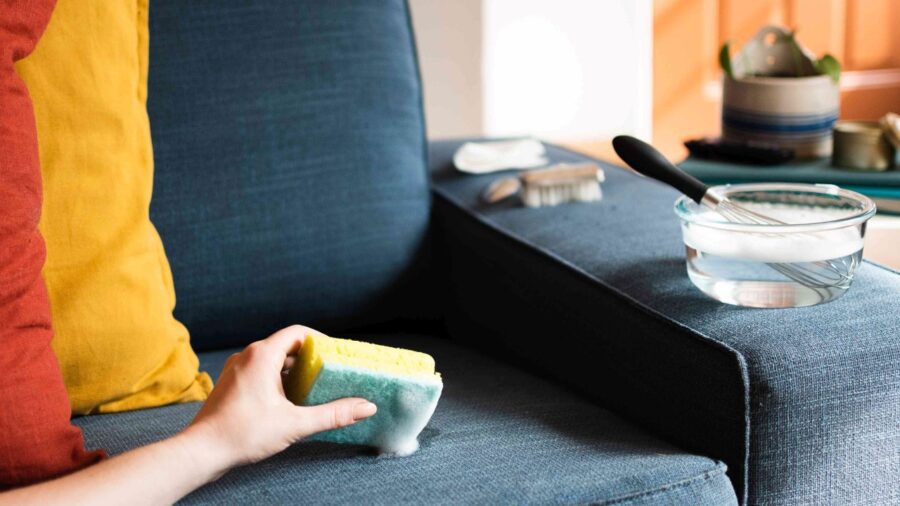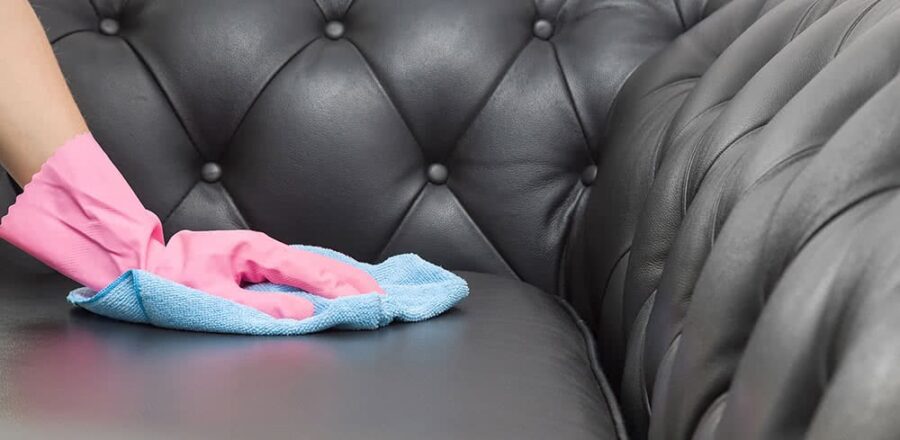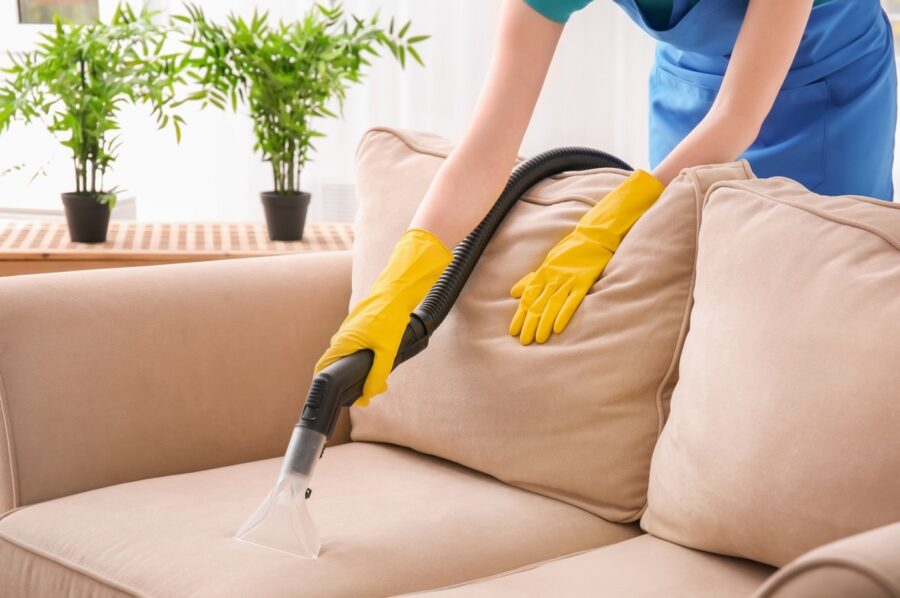
Cleaning Velvet and Leather Upholstery
Cleaning is a must in a human’s life. This is also true when it comes to furniture and upholstery repair. To ensure upholstered furniture lasts longer and provides maximum comfort, it’s essential to clean it properly. To know the reason for upholstery cleaning, you need to read our article in this respect. However, cleaning each of the fabrics needs a couple of advice and some considerations. Therefore, in this article, we will discuss all this information. So, to have better-upholstered pieces of furniture, read this article!
How to clean leather upholstered furniture?

As mentioned earlier, you cannot apply a set of cleaning ways to all kinds of fabrics. Therefore, we want to provide tips for different fabrics. We will start with the leather one.
Leather is the shiniest and the most beautiful fabric for upholstery repair, for sure! By seeing a leather upholstered piece of furniture, we think about the classy the place or the office of furniture is. However, it is one of the most vulnerable fabrics ever. You need to take care of it, like your baby or your pet!
To take care of this fabric as well as possible, you must consider a set of things in cleaning. In Limitless Upholstery, we use full and semi-aniline leather across all our products. Quick refresher: “Aniline” refers to the dying process a hide goes through once it’s been tanned. Full aniline retains its natural markings (think bug bites, scratches, etc); semi-aniline has a thin layer of wax applied before dying to help colour be absorbed more evenly. Semi-aniline leather has a more uniform appearance.
Maintenance
Aniline refers to the dying process a hide goes through once it has been tanned. We feature two different types of aniline in our collection: full-aniline and semi-aniline.
We love full aniline leather because it’s especially forgiving. General wear shows up on the couch but quickly gets in step with the overall look and blends right in. Cleaning both full-aniline and semi-aniline leather furniture is the same, and it’s simple. Once a week grab a clean, damp cloth and use it to wipe or buff away noticeable stains. Use a brush vacuum attachment to clear up debris and crumbs from tufts, seams, and corners. Doing this regularly keeps debris from caking into hard-to-reach areas.
To keep your leather looking its best, commit to giving it a regular wipe-down with a leather conditioner for hydration and shine.
If you spill something on your leather couch, cover the offending spill with a soft, dry cloth to soak up excess moisture. Take special care not to rub the stain! We get it: you’re nervous about your couch, and scrubbing seems like a good way to get your stain out. It simply encourages the stain to sink in further and set. Walk away. Once the initial spill is soaked up, gently clean the area by wiping it with a damp cloth. From there, you can assess what further action is necessary. You may be pleased to see that the stain is gone. If it’s left a noticeable mark, consult a leather specialist or your local dry cleaner.
Fabric furniture and the ways of cleaning
This is a two-pronged effort. Since all your fabric pieces will benefit from regular vacuuming, you’re going to want to take a hard look at how clean that vacuum is. Prior to vacuuming, it is imperative to verify that the vacuum head is pristine and clear of any filth or debris. After use, it’s important to wipe down the bristles thoroughly and sanitize the canister to prepare it for collecting new dirt. We’ll let you determine how hard you need to scrub your sucker, but keep in mind that the cleaner your cleaning tools, the cleaner your home. Consider that ultimate furniture cleaning guide tip number two. Bam.
Fabric upholstered furniture is what vacuum attachments are made for. Literally. The fabric attachment specifically is a small rectangular piece with soft bristles around the suction area. Give your fabric furniture a once-over, paying special attention to seams, crevices, and any tufts. A lint roller is handy for prying especially stubborn debris (couch, pet hair, cough) loose.
Regarding spills
We’re not trying to stress you out, but time is of the essence here. The faster you attend to the spill, the less chance it has of setting into the fabric. The moment you see that dollop of dip or splash of red wine hit, grab a clean absorbent cloth or paper towel. Contain your impulse to scrub. Remember — that will only push the spill deeper into the fibres. Instead, simply place the cloth over the spill.
Leave the cloth in place until all the liquid has been absorbed. After, air dry or use a blow dryer on a low setting to dry out. You’ll be surprised at how effective this simple measure can be.
Once the spill is dry, assess whether it needs further attention. If there is a stain, add a small squeeze of dishwashing detergent to a half cup of water and shake well. Use the resulting suds to clean the stain — but again, do not rub too vigorously. Instead, blot and dry. If you’ve got a major stain going on, or are experiencing some heavy soiling (yikes), consult a furniture cleaning specialist.
Weaves or upholstery that fall under this category include:
- New Zealand wool
- Wool
- Viscose
- Cotton
- Merino felt
- Blends of the above
How to clean velvet furniture?

Like its cousin fabric, velvet furniture loves good, regular vacuuming. Vacuuming keeps velvet looking tidy and helps the fibres stand up, which maintains the shimmery depth of its pile. As with fabric, use the fabric attachment of your vacuum, with short, brisk strokes, vacuum your velvet, paying close attention to the divots and seams. Getting grit out early and often will preserve your velvet pieces for years to come.
One issue that is unique to velvet pieces is “crush marks” from packaging, heavily stacked items, or very long movie marathons. You may notice them as silvery lines running through your sofa pile. Thankfully, they are simple to remove.
Knock knock. Who’s there? If you have crushed velvet furniture, don’t panic! Those marks are just the flattened velvet pile. Use this tip to clean it up and make it look brand new again. don’t worry! These crush marks are just the velvet pile that’s been flattened. You can remove them by using a steamer to gently undo the smashing, lift the pile, and eliminate the creases. Between steams, gently brush in the opposite direction of the velvet pile to release the wrinkles.
For spills — again with the “time is of the essence” thing. As with fabric, the minute you see a spill, get thee to a clean damp cloth and mop up the spill. Avoid scrubbing, instead of waiting for the spill to absorb and dry fully before assessing step two in your clean-up query. To achieve the best results in removing stains, it is imperative that you utilize the dish soap and water method for small and easily manageable stains. However, for more substantial and challenging mishaps, it is imperative to seek assistance from a certified professional within your vicinity.
Weaves or upholstery that fall under this category include:
- Cotton velvet
- Tufted velvet
In the article, we provided almost all the information regarding the cleaning of velvet and leather furniture. We promise you that you will have great pieces of furniture if you consider all the information provided in this article. However, whenever you had a question in this respect, do not hesitate to contact Amin Upholstery experts.
